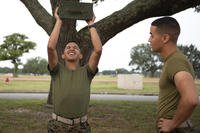If you need to improve your pull-ups and your run times to pass or max out the more challenging fitness tests in the military, here is a pulling and running day workout that can help you meet your goals. Building the strength to do your first pull-up and then working to turn that strength exercise into a muscle stamina exercise can be accomplished by adding more repetitions to your maximum total.
For tests used by the Marine Corps, Army Airborne/Ranger, Special Forces, Navy SEAL, EOD/Diver, SWCC and Rescue Swimmer, and Air Force Special Warfare IFT/OFT, pull-ups and running are usually the events that challenge people the most.
Many of these tests also involve swimming events, so the final piece of the workout will also address swimming.
Warm up with the Pull-up Ladder 1-10 with 100-meter run between each set. Eventually, this will become an easy warmup for you.
This 1-10 warmup ladder equals 55 total pull-ups and 1,000 meters of jogging. If this is too much for you at first, just go to level 5 of the ladder or replace pull-ups with assisted pull-ups or pulldowns until you can do double-digit repetitions of pull-ups.
- 1 pull-up, run 100 meters
- 2 pull-ups, run 100 meters
- 3 pull-ups, run 100 meters
- Keep going to 10 pull-ups
See what you can do with pull-ups until you hit a wall. Then finish with a set of pulldowns with moderately heavy weight that makes 10 repetitions challenging.
Rest with the core element that will be tested in your fitness test (plank or sit-ups). This should be the meat of your repetitions for pull-ups as you are warmed up and fresh, so pull hard.
Repeat three times.
- Pull-ups: max
- Pulldowns: 10
- Sit-ups or plank pose: 1 minute
The next section adds running to pulling exercises and helps you work the muscles of the pull-up (grip, biceps, back). Learning to run after doing pull-ups is a process of getting the blood from the arms and upper body to the legs, where it will be needed during the run.
We do this with a process called the PFT Transition. Use the 10 minutes between your last calisthenics testing event and the run to loosen up the upper body before you start the time on the run. This is a useful strategy that requires practice. Read more about the PFT Transition.
Repeat three times.
- Run: 800 meters at goal pace
- Pull-ups: max
- Heavy rows: 5-10
- Biceps curls: 5 heavier,10 lighter
Work on running at your goal pace for the timed run on your test. If you want to run a six-minute mile, that is a three-minute, 800-meter (half-mile) run. That pace will yield a nine-minute, 1.5-mile; 12-minute, two-mile; and an 18-minute, three-mile timed run for the typical military running distances.
You need to learn your goal pace when you are also training for upper-body exercises so that you get used to the transition from upper-body exercise to running.
If you wanted to add in just a run prior to the swim portion, feel free to add the run distance at which you will be tested at the end of the land workout.
Many of the Special Operations/Diving/Special Warfare tests include swimming. You can top off the above workout with one of my favorite swim workouts, one that will prepare you for freestyle or combat swimmer stroke swimming events (depending on your branch of service).
Check out the 50-50 with pull-outs added for a little more pulling activity while in the water:
Swim 500 meters to warm up.
Repeat 10 times.
- Freestyle: 50 meters fast
- CSS or side stroke: 50 meters
- Pull-outs: 10 (muscle up on pool edge)
The pull-out is simply pulling your torso out of the pool, using the deep-end pool edge. It looks like a pull-up where your head goes underwater in the down position, and you pull your body out of the water until your waist is touching the pool edge next to your hands. Consider it an easier form of the muscle-up.
You can decide where you place the swim section of this workout. You can start this training day with the swim, especially if your Navy PST has the swim placed first in the order of exercises, or you can keep it at the end if working to prepare yourself for the Air Force Special Warfare test (swim last) order of events.
There is a lot of pulling in this workout. Limit this workout to two or three times a week maximum, with 48 hours between each pulling day.
On the days between, you can focus on leg day or push day, using the common split routine of Push/Pull/Legs. Try some of the workouts that test preparation and strategies to help you score at your optimal level.
Stew Smith is a former Navy SEAL and fitness author certified as a Strength and Conditioning Specialist (CSCS) with the National Strength and Conditioning Association. Visit his Fitness eBook store if you're looking to start a workout program to create a healthy lifestyle. Send your fitness questions to stew@stewsmith.com.
Want to Learn More About Military Life?
Whether you're thinking of joining the military, looking for fitness and basic training tips, or keeping up with military life and benefits, Military.com has you covered. Subscribe to Military.com to have military news, updates and resources delivered directly to your inbox.


















